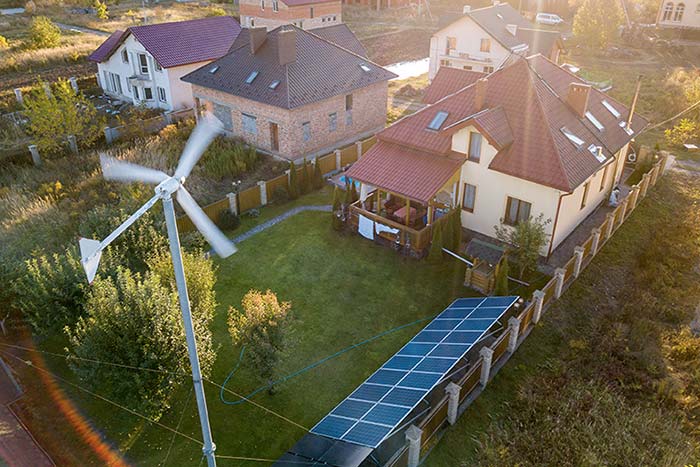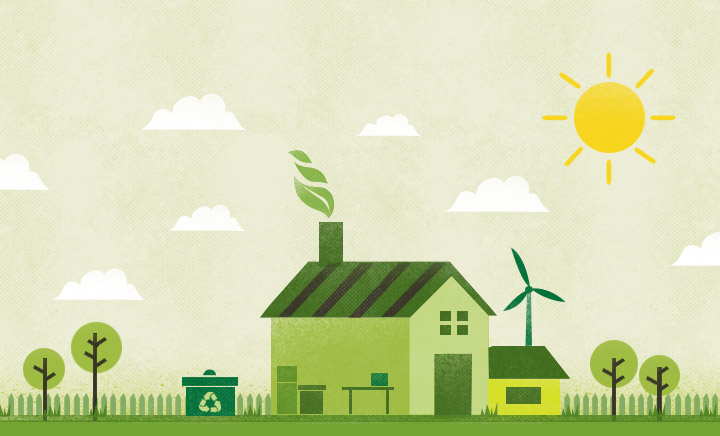
In today's environmentally conscious world, individuals and communities are constantly seeking innovative ways to live a greener lifestyle.
This article presents 10 ingenious green living ideas that range from waste reduction strategies to eco-friendly transportation options.
By implementing these solutions, individuals can contribute to a more sustainable future by reducing their carbon footprint, conserving energy, and making eco-friendly choices in various aspects of their daily lives.
Join us as we explore these practical and effective ideas for a greener, more sustainable way of living.
Waste Reduction
Waste reduction is a core objective that environmental enthusiasts strive to accomplish through the implementation of effective recycling programs and waste management strategies. By adopting upcycling projects and embracing a plastic-free living, individuals can significantly contribute to minimizing waste generation and its detrimental impact on the environment.
Upcycling projects involve transforming waste materials into new products with higher value or utility, thereby extending their lifespan and diverting them from landfills. This approach not only reduces waste but also promotes creativity and innovation.
Additionally, adopting a plastic-free lifestyle entails reducing the consumption of single-use plastics and opting for eco-friendly alternatives, such as reusable bags and water bottles. By making conscious choices and seeking sustainable alternatives, individuals can actively participate in waste reduction efforts, preserving the environment for future generations.

Homemade Natural Products
One way to embrace sustainable living is by making homemade natural products. DIY skincare and zero waste cleaning are two areas where individuals can take control of the ingredients they use and reduce their environmental impact.
By creating their own skincare products, individuals can avoid harmful chemicals and plastic packaging, while also saving money. Simple ingredients like coconut oil, shea butter, and essential oils can be used to make moisturizers, lip balms, and body scrubs.
In terms of cleaning, homemade natural products can replace store-bought cleaners that often contain harsh chemicals. Ingredients like vinegar, baking soda, and lemon juice can be used to create effective cleaning solutions.
Energy Conservation
How can individuals contribute to energy conservation in their everyday lives?
One effective way is by using energy-efficient appliances. These appliances are designed to consume less energy while still providing the same level of functionality. By replacing old, energy-guzzling appliances with energy-efficient ones, individuals can significantly reduce their energy consumption and lower their utility bills.
Another way to contribute to energy conservation is by utilizing renewable energy sources. Renewable energy sources, such as solar and wind power, are sustainable and do not deplete natural resources. Installing solar panels on rooftops or investing in community wind farms are great ways to harness renewable energy for personal use.
Green Energy Sources
Green energy sources play a pivotal role in sustainable living and environmental preservation. By harnessing renewable power, we can reduce our dependence on fossil fuels and mitigate the harmful effects of climate change.

One of the most popular green energy sources is solar panels, which convert sunlight into electricity. Here are four reasons why solar panels are an excellent choice for green energy:
- Renewable: Solar energy is derived from sunlight, a resource that is abundant and inexhaustible.
- Clean: Solar panels produce electricity without emitting greenhouse gases or other pollutants, making them environmentally friendly.
- Cost-effective: While the initial installation cost may be high, solar panels can significantly reduce electricity bills in the long run.
- Self-sufficiency: Solar panels allow individuals and communities to generate their own power, reducing reliance on the traditional power grid.
Sustainable Food Choices
Sustainable food choices are an essential aspect of green living, as they further contribute to waste reduction and environmental preservation.
One sustainable food choice is adopting plant-based diets. Plant-based diets emphasize the consumption of fruits, vegetables, grains, legumes, and nuts, while minimizing or eliminating the consumption of animal products. By choosing plant-based diets, individuals can reduce their carbon footprint, as the production of plant-based foods generally requires fewer resources and generates fewer greenhouse gas emissions compared to animal-based foods.
Another sustainable food choice is supporting local farming. Local farming involves purchasing food that is grown and produced locally, reducing the need for long-distance transportation and supporting the local economy. Additionally, local farming often promotes sustainable farming practices, such as organic farming and agroforestry, which help preserve soil health and biodiversity.
Responsible Consumption
Responsible consumption is a crucial aspect of sustainable living. By adopting a minimalist lifestyle, individuals can significantly reduce their environmental impact.
Making conscious choices about what we purchase and consume can lead to a more sustainable and eco-friendly future.
Minimalist Lifestyle Benefits Environment
A minimalist lifestyle can significantly contribute to environmental preservation through conscious and mindful consumption habits. By embracing a minimalist lifestyle, individuals reduce their ecological footprint and promote sustainability. Here are some ways in which a minimalist lifestyle benefits the environment:

- Reduced waste: Minimalists prioritize quality over quantity, leading to less waste generation. They tend to buy only what they need, reducing the demand for unnecessary products and packaging.
- Sustainable fashion: Minimalists opt for timeless, high-quality clothing items instead of fast fashion trends. This choice promotes sustainable fashion practices, such as buying from ethical brands and choosing durable materials.
- Green building: Minimalists often prefer smaller living spaces, which require fewer resources to build and maintain. They also prioritize energy-efficient appliances and sustainable building materials, reducing their carbon footprint.
- Responsible consumption: Minimalists focus on the essentials and avoid excessive consumerism. This mindset encourages conscious purchasing decisions and encourages a shift towards a more sustainable and responsible consumption pattern.
Impact of Conscious Choices
By making conscious choices in their consumption habits, individuals can play a significant role in promoting a greener and more sustainable future. Conscious consumerism is an approach that encourages individuals to consider the environmental and social impact of their purchases. It involves being mindful of the resources used in the production process, the working conditions of the workers involved, and the overall sustainability of the product or service.
Environmental mindfulness is another aspect of responsible consumption, which involves being aware of the ecological consequences of our choices and actively seeking out alternatives that minimize harm to the environment. This can include opting for products made from recycled materials, supporting local and organic food, and reducing energy and water consumption.
Recycling and Composting
Implementing effective recycling and composting practices is crucial for achieving sustainable waste management in a green living lifestyle.
Recycling involves transforming waste materials into new products, reducing the need for raw materials and minimizing energy consumption.
Composting, on the other hand, is the process of decomposing organic waste, such as food scraps and yard trimmings, into nutrient-rich soil.
Here are some compelling reasons to embrace recycling and composting:
- Reduce landfill waste: Recycling and composting divert waste from landfills, reducing the environmental impact of waste disposal.
- Conserve resources: By recycling materials, we can conserve natural resources like timber, water, and minerals.
- Decrease greenhouse gas emissions: Recycling and composting help reduce the emission of greenhouse gases, contributing to climate change mitigation.
- Promote sustainability: Recycling and composting are essential components of a circular economy, where resources are reused and waste is minimized.
Eco-friendly Packaging
Continuing the focus on waste reduction and sustainability, the next aspect to explore is the implementation of eco-friendly packaging practices.

Sustainable materials and innovative designs are key components in creating packaging solutions that minimize environmental impact. Using sustainable materials, such as biodegradable or recyclable materials, reduces the use of non-renewable resources and minimizes waste generation.
Additionally, innovative designs can optimize packaging size and shape, reducing the amount of material required and maximizing the use of space. This not only reduces packaging waste but also lowers transportation costs and carbon emissions.
Companies can also consider incorporating reusable packaging options, such as refillable containers or packaging made from renewable resources.
The reduction of carbon footprints is an essential aspect of sustainable practices in green living. By lowering our carbon emissions, we can mitigate the harmful effects of climate change and create a healthier planet for future generations.
To achieve this, here are some effective strategies:
- Carbon offsetting: Investing in projects that reduce greenhouse gas emissions, such as renewable energy or reforestation, to compensate for our own carbon footprint.
- Sustainable transportation options: Opting for public transportation, biking, or walking instead of driving, and choosing electric or hybrid vehicles when necessary.
- Energy-efficient practices: Conserving energy by using energy-efficient appliances, properly insulating our homes, and reducing energy consumption.
- Conscious consumption: Being mindful of our purchasing choices, supporting eco-friendly products, and minimizing waste.
Eco-friendly Transport
To promote sustainable transportation, individuals can explore various eco-friendly transport options.
Electric vehicles (EVs), for example, are gaining popularity as a clean and efficient means of transport. These vehicles run on electricity, reducing greenhouse gas emissions and dependence on fossil fuels. With advancements in technology, EVs now offer longer ranges and faster charging times, making them a viable alternative to conventional vehicles.

Additionally, bicycle commuting is another eco-friendly transport option that promotes physical activity while reducing carbon emissions. By opting for bicycles instead of cars for short-distance trips, individuals can contribute to a healthier environment and improve their own well-being.
Governments and organizations can play a crucial role in promoting these alternatives by providing infrastructure such as charging stations and bike lanes, and offering incentives for their adoption.
Frequently Asked Questions
How Can I Reduce Waste in My Daily Life Beyond the Tips Mentioned in the Waste Reduction Section?
To further reduce waste in daily life, consider reducing single use plastics by using reusable alternatives, such as water bottles and shopping bags. Additionally, upcycling clothing can extend their lifespan and reduce textile waste.
Are There Any Specific Homemade Natural Products That Can Be Used for Cleaning and Personal Care?
Homemade skincare products and eco-friendly cleaning solutions offer a natural and sustainable alternative to conventional products. By using ingredients like vinegar, baking soda, and essential oils, individuals can reduce their environmental impact while maintaining personal care and cleanliness.
What Are Some Practical Ways to Conserve Energy in an Office or Workplace Setting?
In a workplace setting, practical ways to conserve energy include implementing energy-saving technology, such as motion-sensor lighting and smart thermostats. Renewable energy options, such as solar panels, can also be considered to reduce dependence on fossil fuels.
What Are Some Examples of Green Energy Sources That Can Be Easily Incorporated Into Residential Homes?
Green energy sources for residential homes include solar panels, wind turbines, and geothermal systems. Energy efficient appliances, such as LED lighting and smart thermostats, can also be incorporated. These renewable energy options reduce reliance on fossil fuels and lower carbon emissions.
Are There Any Specific Sustainable Food Choices That Are Not Mentioned in the Sustainable Food Choices Section?
When exploring sustainable food choices, it is important to consider options beyond those mentioned in the sustainable food choices section. Additionally, alternative energy sources for transportation can also play a significant role in promoting green living.

 Family Craft ProjectsHome ImprovementCooking and BakingReuse and RecycleDIY GiftsEco-Friendly ProjectsDIY Home SolutionsSeasonal ActivitiesFun and GamesLearn TogetherPrivacy PolicyTerms And Conditions
Family Craft ProjectsHome ImprovementCooking and BakingReuse and RecycleDIY GiftsEco-Friendly ProjectsDIY Home SolutionsSeasonal ActivitiesFun and GamesLearn TogetherPrivacy PolicyTerms And Conditions

 Family Craft ProjectsHome ImprovementCooking and BakingReuse and RecycleDIY GiftsEco-Friendly ProjectsDIY Home SolutionsSeasonal ActivitiesFun and GamesLearn TogetherPrivacy PolicyTerms And Conditions
Family Craft ProjectsHome ImprovementCooking and BakingReuse and RecycleDIY GiftsEco-Friendly ProjectsDIY Home SolutionsSeasonal ActivitiesFun and GamesLearn TogetherPrivacy PolicyTerms And Conditions
